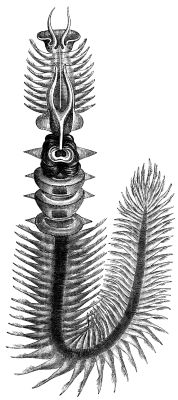Chaetopteridae
| Chaetopteridae | ||||||||||||
|---|---|---|---|---|---|---|---|---|---|---|---|---|

Chaetopterus variopedatus (Renier, 1804). From Brehms Thierleben , Leipzig 1887. |
||||||||||||
| Systematics | ||||||||||||
|
||||||||||||
| Scientific name | ||||||||||||
| Chaetopteridae | ||||||||||||
| Audouin & Milne Edwards , 1833 |
Chaetopteridae is the name of a family of small to medium-sized tube - forming polychaeta (polychaeta) that live as filter feeders and that can be found in seas around the world.
features
The many bristles of the Chaetopteridae family have a small, rounded prostomium on which the two nuchal organs are located on the sides , but antennae are missing. Two very long palps with a longitudinal groove sit on the peristomium . An eyelash line runs along the entire back. The fragile body of the Chaetopteridae is divided into three sections by the size and shape of the parapodia : Only notopodia sit on the parapodia of the front segments , while the parapodia in the middle section are branched with protruding bristleless notopodia and neuropodia . The parapodia protrude less on the posterior segments, and both lobes are pointed or the neuropodia are formed as tori . Cirrus on the back, abdomen or pygidium are absent, as are gills or aciculae. The bristles are lanceolate hairs, modified spines on the front of the 4th bristle-bearing segment and hooks on the middle and rear neuropodia. The front part of the body is flattened dorsoventrally with glands on the abdomen that secrete the mucus for the living tube. The living tubes are cut using the bristles on the 4th bristle-bearing segment. The wing-like notopodium on the 12th segment in the middle section of the animals secretes mucus with which food particles are captured from the water. The enlarged notopodia are held against the tube wall and thereby generate a flow of water.
Distribution, habitat, way of life and example species
The Chaetopteridae are distributed worldwide in the seas of temperate and tropical latitudes. They live in vertical or U-shaped tubes, which they drill into the sediment or into the hard substrate on the sea floor and line them with hardening slime. They live as filter feeders who use the wing-shaped notopodia located on the 12th segment to produce a slime network and thereby capture food particles from the seawater. The net grows up to a millimeter per second and is eventually separated, reversing the flow of water and transporting the food ball to the mouth through the eyelashes on the back.
Chaetopterus variopedatus is the best studied species, but it is controversial whetherit should includeall Chaetopterus : In this case, it is a cosmopolitan species occurring worldwide. The species builds its tubes in depths from the intertidal zone to the continental shelf soft sediment, but tubes are alsodrilledin rotting wood such as piles on piers . While the tubes of Chaetopterus are often U-shaped, the worms of the other genera drill branched and irregular tunnel systems, mostly in soft substrate.
Development cycle
The development of the Chaetopteridae takes place like with most of the many bristles over a long-lasting, free-swimming larval stage, which enables a wide distribution of the animals and thus cosmopolitan species. The larvae have a barrel shape with one or two rows of eyelashes in the middle section and a large mouth funnel, with which they differ from the typical trochophora , and with lengths of 0.4 mm to 2.5 mm in the terminal stage are among the largest among the marine annelid worms. The metamorphosis takes place after fixing the mask to the seabed, wherein the 15 segments of the young Chaetopterus worms are formed by dividing an existing system.
Systematics
Molecular genetic studies by TH Struck and others in 2011 suggest that the Chaetopteridae are a very basal group of annelids that split off before the injection worms .
The Chaetopteridae family includes the following four genera with around 30 described species :
- Chaetopterus Cuvier, 1830
- Mesochaetopterus Potts, 1914
- Phyllochaetopterus Grube, 1863 (including the synonymized genus Mesotrocha Leuckart & Pagenstecher in Leuckart, 1855 )
- Spiochaetopterus M. Sars, 1856
literature
- Stanley J. Edmonds: Fauna of Australia, Volume 4A. Polychaetes & Allies. The Southern Synthesis 4. Commonwealth of Australia, 2000. Class Polychaeta. Pp. 258-261, Family Chaetopteridae.
- KJ Osborn, GW Rouse, SK Goffredi, BH Robison (2007): Description and relationships of Chaetopterus pugaporcinus, an unusual pelagic polychaete (Annelida, Chaetopteridae). The Biological Bulletin 212 (1), pp. 40-54. doi: 10.2307 / 25066579 . PMID 17301330
- TH Struck, C. Paul, N. Hill, S. Hartmann, C. Hösel, M. Kube, B. Lieb, A. Meyer, R. Tiedemann, GN Purschke, C. Bleidorn (2011): Phylogenomic analyzes unravel annelid evolution . Nature 471 (7336), pp. 95-98. doi: 10.1038 / nature09864 . PMID 21368831
- E. Ruppert, R. Fox, R. Barnes (2007): Invertebrate Zoology: A functional Evolutionary Approach . 7th edition. Belmont: Thomson Learning. ISBN 0-03-025982-7 .